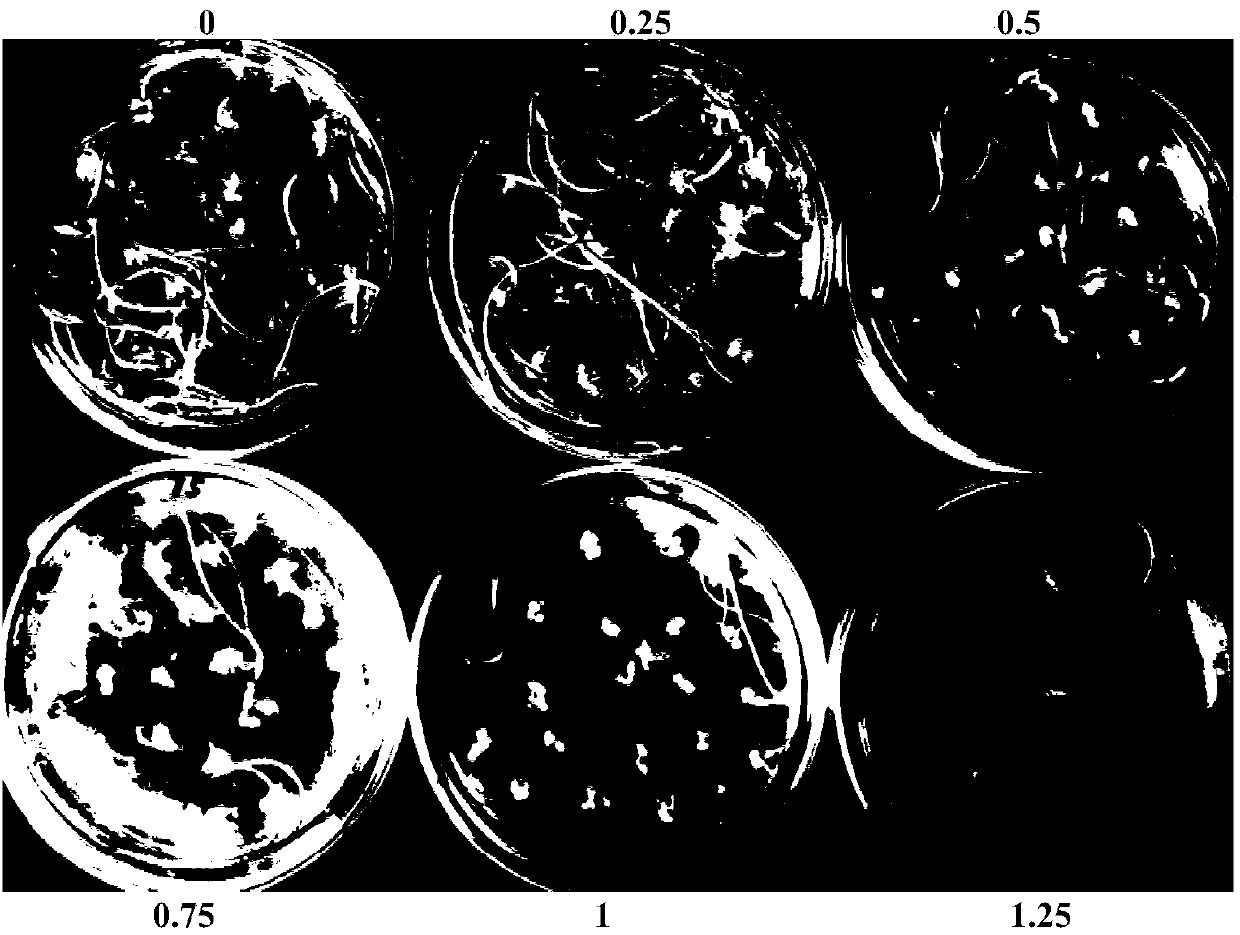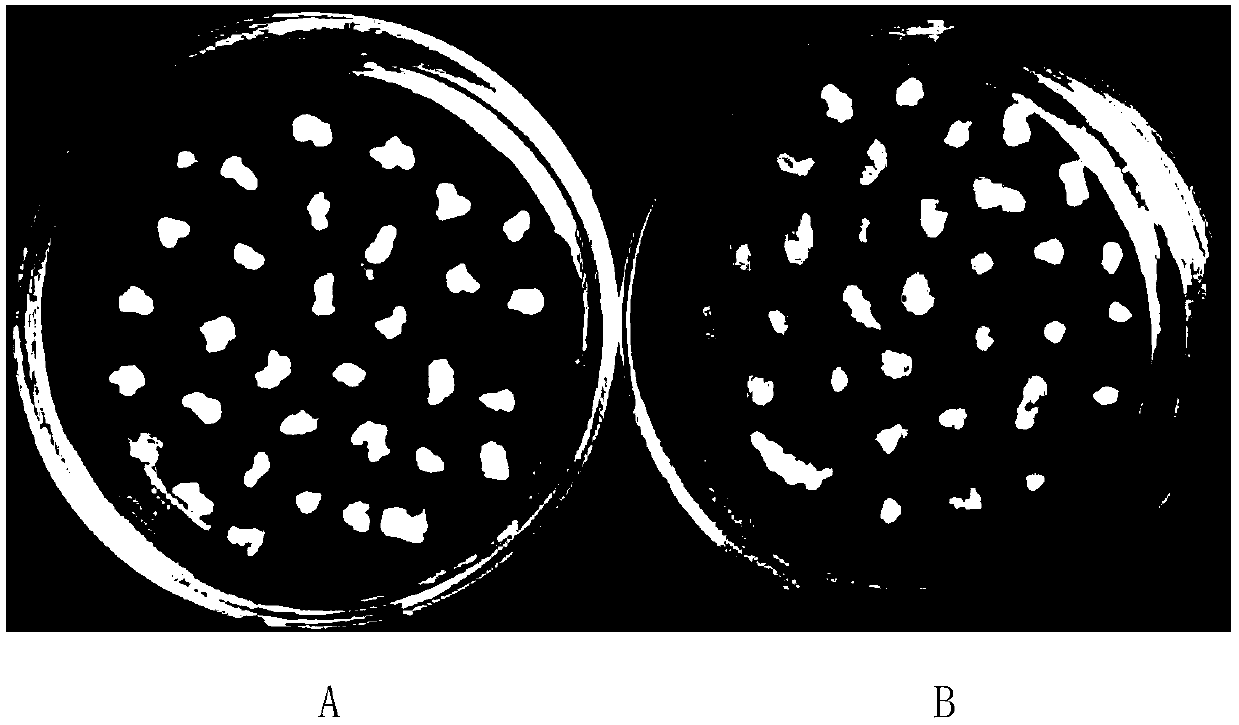Dry-germ dissociation method applied to wheat mature embryo culture
A wheat and grass plant technology, applied in the field of dry embryo dissociation, can solve the problems of time-consuming and labor-intensive, easy to pollute, complicated operation, etc., and achieve the effects of saving storage space, labor, and facilitating tissue culture and genetic transformation.
- Summary
- Abstract
- Description
- Claims
- Application Information
AI Technical Summary
Problems solved by technology
Method used
Image
Examples
Embodiment 1
[0044] Embodiment 1, the exploration of experimental conditions
[0045] 1. Preparation of dry embryo tissue
[0046] Evenly crush the grains of the wheat variety "Liaochun No. 18", first pass through a 9-mesh sieve to remove large particles, and then pass through a 30-mesh sieve to remove small particles, from the particles whose particle size is between 9-mesh sieve and 30-mesh sieve Pick embryonic tissue (light yellow, crescent-like in shape, 1-2mm in size, accounting for about 40% of the broken tissue), and put it in a 1.5ml centrifuge tube for later use. For photos during the screening see figure 1 , A and B are particles whose particle size is between 9 mesh sieve and 30 mesh sieve, C is endosperm particle whose particle size is between 9 mesh sieve and 30 mesh sieve, D is between 9 mesh sieve and 30 mesh sieve The granules of the embryo in between.
[0047] 2. Exploration of disinfection time
[0048] 1. Take the embryo tissue obtained in step 1, wash it 2-3 times w...
Embodiment 2
[0065] Embodiment 2, the application of the method provided by the present invention
[0066] 1. Evenly crush the grains of the wheat variety "Liaochun No. 18", first pass through a 9-mesh sieve to remove large particles, and then pass through a 30-mesh sieve to remove small particles, from the grain size between 9-mesh sieve and 30-mesh sieve Pick the embryonic tissue (light yellow, crescent-shaped, 1-2mm in size, accounting for about 40% of the broken tissue) from the granules, and put it in a 1.5ml centrifuge tube for later use.
[0067] 2. Take the embryo tissue obtained in step 1, wash it with sterile water for 2-3 times, then disinfect it with 2.5g / 100ml sodium hypochlorite aqueous solution for 1 minute, and then rinse it with sterile water for 3-5 times.
[0068] 3. Inoculate the embryo tissue after step 2 into the induction medium (80 embryo tissues per culture dish, repeat 3 culture dishes), culture in the dark at 25°C for 1 week (see photo image 3 A). The callus g...
Embodiment 3
[0074] Embodiment 3, comparison method
[0075] 1. Take the grains of the wheat variety "Liaochun No. 18", soak them in 70% (volume ratio) alcohol solution for 10 minutes, and then soak them in 2.5g / 100ml sodium hypochlorite solution for 25 minutes.
[0076] 2. Take the seeds that have completed step 1 and soak them in water for 12 hours.
[0077] 3. Take the seeds that have completed step 2 and soak them in sodium hypochlorite solution for 15 minutes.
[0078] 4. Take the seeds that have completed step 3, scrape the embryos of the seeds gently with a sharp knife 5-6 times, and inoculate the mince (the mince of each embryo is inoculated to the same position of the induction medium as 1 piece) into the induction medium , cultured in the dark at 25°C for 1 week (see image 3 B). The callus generation rate was 94.1% (the average value of 3 petri dishes).
[0079] 5. Same as step 4 of embodiment 2.
[0080] 6. Same as step 5 of embodiment 2. The callus was cultured in the di...
PUM
 Login to View More
Login to View More Abstract
Description
Claims
Application Information
 Login to View More
Login to View More - R&D
- Intellectual Property
- Life Sciences
- Materials
- Tech Scout
- Unparalleled Data Quality
- Higher Quality Content
- 60% Fewer Hallucinations
Browse by: Latest US Patents, China's latest patents, Technical Efficacy Thesaurus, Application Domain, Technology Topic, Popular Technical Reports.
© 2025 PatSnap. All rights reserved.Legal|Privacy policy|Modern Slavery Act Transparency Statement|Sitemap|About US| Contact US: help@patsnap.com



